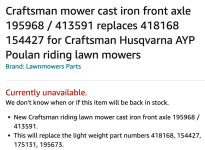Question:
Why are you looking to replace the 2-piece axle with a cast one-do you do a LOT of mowing, or mow where there are a lot of short stumps or rocks to run into?
It takes an awful lot to TWIST one of the steel axles.
That one in the photo looks as if someone ran it fast and hit a tree or other obstruction hard with the right front wheel. (Probably downhill, which would give it more momentum.)
For what its worth, a cast IRON axle can be broken by the same type of impact.
A cast STEEL one would bend.
I believe that these axles are probably cast iron, but it would be smart to find out for sure.
The cast front axles will interchange with many of the 2-piece steel axles-as long as the overall dimensions are similar, and the spindle lean angles are also similar.
HOWEVER, there are minor differences in the center BUSHING SET that supports the axle pivot bolt and in the bushings used to support the right and left spindles. The difference is the diameter of the 3 holes in the axle. If I remember correctly, the cast axle has pressed in bronze bushings top and bottom where the steel axle uses thin plastic bushings. I believe that there is a thin needle bearing set that can be used below the cast iron axle on the spindles. (This would only be possible with a flat, machined surface, which the cast axle has and the steel axles do not.)
There is also available a much sturdier set of front and rear axle braces that work with that cast axle-to replace the thin stamped L-shaped plates that are on your mower now.
The axle brace plates are flat, much thicker gauge steel, and are taller. They use bolts to go through both of them to clamp them together where the short legs of the "Ls" are. Those through bolts above and below the axle itself make for a rigid assembly, which bolts onto the chassis instead of having 2 separate pieces that can each lean outwards.
THIS brace pair MAY or MAY NOT work with a particular steel axle, as some of the steel axles have protruding flanges and have different profiles that make them taller in cross section than the cast ones are-at the points where the through bolts that connect the braces are. If an axle with a taller cross section is used with those braces, it would decrease the available up and down swing angle movement of the axle.
However, if the ONLY difference is the amount that the flanges themselves protrude, those flanges COULD be ground down (notched) at those specific points to regain some of the swing angle. If one werre to be grinding,its a good idea to add more stitch weld to the steel axle if any section of welding is removed-to regain the original stiffness. (I did the entire perimeter of one.of mine.)
One more thing.
I believe that there may be different LENGTH axles out there, and if so, those would either require different length drag links to connect the spindles to each other, or different spindles with differently placed holes for the same drag link to attach to. If a different length axle from the original is used and an incompatible drag link used with it, the wheels would either point inwards or outwards instead of straight ahead.


